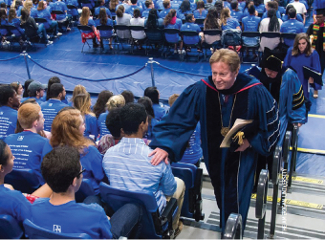
For much of his career, Cornelius M. (Neil) Kerwin has moved easily from college classroom to corporate boardroom. He is comfortable in both settings and counts professors and chief executive officers among his many colleagues. Because successful business practices are finding a place in academic governance and because corporate leaders are accepting appointments as seminary trustees, In Trust invited Kerwin to share his insights on the blending of the two cultures.
Kerwin is president emeritus and current professor of public policy and management at American University in Washington, D.C. He has been a member of such diverse boards as the National Association of Independent College and Universities, the American Council on Education, the District of Columbia Chamber of Commerce, and the Washington Board of Trade.
Kerwin was interviewed for In Trust by Jay Blossom, publisher, and G. Douglass Lewis, president emeritus of Wesley Theological Seminary and former chair of the board of directors of the In Trust Center for Theological Schools.
Q From your experience on both corporate and campus boards, how would you say the two cultures differ?
A The corporate culture has a distinct set of priorities and values, and the academic culture has its own distinct set of priorities and values. And although of course they share some common elements, corporate and academic values are sometimes in conflict. They have different emphases.
What you find in the corporate world is a clarity of goals directly related to the bottom line. Profits are easily measured, and the measurement is critical to the company’s success and its accountability to shareholders and regulatory bodies.
But it’s not as if the profit motive is pursued at the expense of all other values. In my view, corporations increasingly have a strong eye to civic responsibility, but a certain tension exists between the goals of a corporation and the goals of an institution such as a seminary. In higher education, you have many of the same measures of effectiveness on the financial side, but you have other values that are less easily quantified. They tend to be multiple and sometimes are a bit in conflict. Faculty and students are driven more by academic freedom, inquiry, and a responsibility to service that is independent of a school’s ability to sustain itself financially.
Q Some schools are criticized for being “businesslike” in their governance practices. They’re sometimes accused of focusing too intently on growing their endowments. How do you respond?
A I see very little of that in reality. The change I’ve seen over time is an increase in what is expected of colleges and universities by students, faculty, alumni, and the like. So many requirements are imposed on them by external sources. Institutions have to deliver on their missions in a more complicated and demanding world. Families have heightened expectations, not just for the education of the students they entrust to us, but also for the social and personal development of those students.
I’ve seen the modest regulatory environment of 50 years ago grow into a substantial set of obligations that gives rise to a network of support services. It may look like institutions are focused on making as much money as they can, but the financial bottom line isn’t the end — it’s the means to the end. I’ve known people in academic circles who worry about how they’re going to balance the multiple expectations that are made on them. That’s often misunderstood by constituencies.
I can understand when donors look at a campus and say, “My gosh, do these people ever stop asking for money?” But I think they’ve got to look deeper at what the institutions are trying to do with the money. An endowment is increasingly the vehicle that institutions turn to so they can maintain their commitment to access and diversity.
Q One way for a school to attract funding is to recruit well-resourced business executives to the board of trustees. How do you feel about that trend?
A You’re never going to make a plausible argument that the reason people attend seminary is to get rich. I’m fully aware of the income constraints that clergy face. So schools have to build a network of supporters who are committed to ensuring that students drawn to a vocation such as ministry are able to pursue it without paying for everything themselves. It puts great pressure on institutions to defer as much of the cost of education as possible.
That’s one of the reasons we’re talking about populating boards with people from corporate America — or elsewhere — who have the means. However, potential board members have got to be seen as more than a wallet or checkbook. You better be clear about why you want their service and how you see their skill set working for the seminary.
Q Is there a downside? Often corporate executives who are invited to serve on college boards have little knowledge of higher education. Are there valid reasons — aside from their ability to support the schools financially — for adding them to the mix?
A I’ll give you an unqualified yes! I’m a huge proponent of trustees with business experience because of what they offer besides financial support. Anyone who is running a successful company brings invaluable expertise to the table. This is an individual who knows strategy, understands planning, and has experience with organizational systems, technology, finances, and human resources.
Much of that may not be relevant to the seminary, but some of it could be, especially in broad strokes. One of the challenges for these new board members is to adjust to a more ambiguous institution with multiple goals and a mission that is clearly different in terms of the criteria of effectiveness. This creates a need for them to be appropriately educated in the responsibilities they are about to take on. Potential trustees need to understand the expectations placed on them before joining the board.
Q Are there any red flags that should cause a school to think twice before inviting an executive with business experience to join its board?
A The line I often use is, “Everybody who went to college thinks he can run a college.” That may be true, but I would take it as a red flag if an individual is unwilling to give the time and energy to participate in an in-depth orientation. That would indicate the person won’t be willing to give the time and effort down the line when other priorities intervene.

Courtesy American University
Beyond that, the school needs to do its due diligence, not just on the potential board member, but also on the company where the person works. Don’t assume that board candidates will be used to making decisions and having people immediately act on those decisions. That’s not always the case in an academic setting. Do your candidates understand the critical distinction between being a trustee and being a CEO? As trustees, their responsibility is to provide governance and policy direction, not to oversee day-to-day management.
Q Should governance documents that spell out these responsibilities be given to perspective board members?
A Yes, and if these documents are accurate, clear, complete, and up to date, they will eliminate an immense amount of misunderstanding and, in some cases, alienation down the line. They need to cover the fiduciary obligations of the board as a collective entity and the fiduciary obligations of the individual trustee. An institution should never allow its governance documents to fall into disrepair or for board members to forget that the contents of the documents are their marching orders.
At American University we had a crisis several years ago due to an inadequate appreciation of what board responsibilities were. We revisited our governance documents and the board made a conscious effort to reeducate itself. Since then, every new board member has been required to undergo a day and a half of orientation, which helps to clarify roles and responsibilities.
Q What does such a lengthy orientation look like?
A It typically starts in the morning with a brief meeting with the school president and the board chair and works through the provost, vice presidents, and other administrators. Then we have sessions with leaders of the faculty, student body, and staff. In a large school such as ours we have a chief academic officer, a chief financial officer, a tech guy, and a general counsel. We explain our budgeting process and walk them through some financial management issues.
At some point the board chair talks with the new members about their committee assignments and facilitates any conversations that need to happen between committee chairs and new members. All this takes time. A day and a half sounds like a lot, but it’s often not quite enough.
Q What kind of feedback do you get from new board members who go through the orientation?
A The most common comment I’ve received is, “We had no idea it was as complicated as this.” Once they understand the complexity of higher education governance, the respect they have for the people working in the institution grows.
You’re in trouble if a trustee arrives for the orientation and says, “Well, this is just a school. I run a big organization, so I know a lot more about that than you do.” But with the orientation comes respect, and with respect comes a degree of humility on the trustee’s part.
An effective orientation tests the individual’s willingness to take on the work that will be required. To my knowledge, we never had a trustee quit because of the orientation experience. But if that were to happen, it wouldn’t be a bad thing. With a limited number of seats on a board, all of the trustees have to pull their weight. So, you want to know as early as possible whether or not they’re prepared to do it.
Q What about shared governance? Sometimes there is confusion about the role of the board and the faculty in decision making. How do you avoid such confusion?
A The place to address that issue is in the faculty manual or handbook, which is developed by the faculty with the express approval of the board. I’ve become sort of an expert on these handbooks and have the scars to prove it! I’m amazed when I see manuals that overlook the role of the board of trustees in the governance of their institution. I think it’s a very good practice for board bylaws to acknowledge the roles and powers of the faculty; and I think it’s equally important for faculty manuals to acknowledge and outline the responsibilities of the trustees. It’s in periods of relative calm that boards and other critical constituencies should undertake the work of cleaning up their basic governance documents and making sure that the pertinent information is included. That way, when either side oversteps its bounds and interferes inappropriately, the documents are the foundation for resolving the conflict.



























